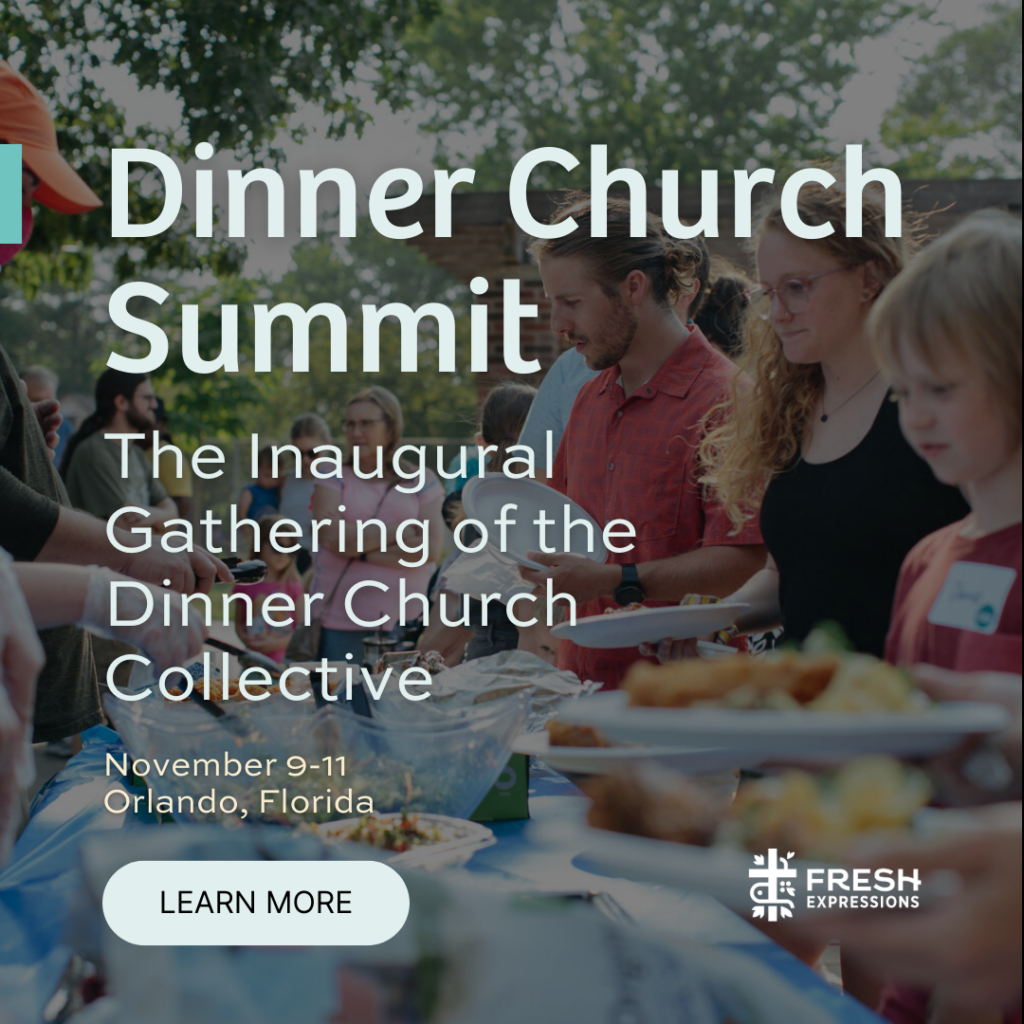As 21st Century Christian leaders, it’s hard to recognize our assumptions about the way church is done.
We take our exclusive religious spaces, teaching-centric gatherings, congregational liturgies, and musical worship experiences for granted. It is easy to forget how the forms we use are particular to our historical stream of the broader church. We can also forget that many of those traditions only go back as far as the Reformers, only 500 years ago.
There is wisdom in the Christian tradition, and many of our forms exist for good reason. But we must admit that much of what we think of as “church” is not found in the Scriptures, or even the first three hundred years of Christianity.
There are other ways for churches to gather that have deep Biblical and historical precedence. A prominent example is dinner church, where Christians and non-believers gather to share food a explore faith.
Did Jesus Invent the “Dinner Church”?
Jesus himself used the dinner table and dinnertime throughout his ministry.
J. Crossan states that if one were to watch a day in the life of Jesus, he would mostly see him healing and eating.
Jesus performed much of his salvific work from a dinner table. Many of the parables were told from a dinner table. Numerous kingdom metaphors assumed a dinner table.
It is not a mystery then why the Acts house churches and the Gentile Agapé churches functioned around dinner tables; they were given that pattern by Jesus himself.
During the Last Supper, Jesus took an annual dinner event and turned it into a vision for doing church by telling his disciples to begin doing what they were doing whenever they met, to continue to gather the poor and the stranger to their table, and to “remember” Christ instead of remembering the rescue event from Egypt. In so doing, Jesus embedded the gospel into the dinner table sociology, and his disciples obviously caught that vision.

The Agape Feast: An Overlooked Piece of Christian History
The dinner table setting of the first Christians is usually overlooked in today’s theological discussions, but its implications are deep and worthy of serious reflection.
Whether it was the house churches introduced in the Book of Acts, or the Agapé churches introduced in the Epistles, church happened around tables of food at dinnertime. The first Christian meals are described as early as Acts 2. Epistles like First Corinthians and James discuss proper ways of eating together, making it clear that gatherings for eating and teaching were central to both the shared life of the first congregations, and their approach to evangelism.
The Apostolic Era Church, generally from the time of the writing of the New Testament until the rise of Constantine’s state-sponsored Church, took place primarily around dinner tables. For instance, the second century Church leader Tertullian describes a regular Christian gathering, that consisted of a meal and a “symposium” time of learning. Reflecting on what had been taught by both Paul and James, Tertullian mentions that participants were careful not to overeat and save food for those in need because “with God there is greater consideration for those of lower degree.” The symposium time provided a space for every believer to share “from what he knows of the Holy Scriptures, or from his own heart, is called before the rest to sing to God” (Tertullian, Apologies 39).
With Jesus’ own life as an example, it should be no surprise that the gospel found a comfortable home at meal times. The familial setting of the dinnertime table made it easy to gather people to the family of God. During the three hundred years when Christian gatherings were dinner churches, the church grew from 20,000 to over 20 million. In other words, many sinners met their Savior over tables of food.
Inviting Someone to Dinner is Different
There is something winsome about inviting people to dinner that cannot be paralleled by inviting them to a Sunday morning “teaching event.” In our day and age, still so influenced by the Reformation, we desperately need to meditate upon what we are actually asking the unchurched population to come to when we invite them to this thing we call church. We must follow up this meditation with another: would inviting our neighbors to dinner be more compelling?
Take a moment right now to think about one of your neighbors who isn’t a part of a church. Imagine inviting that person to come with you to a worship gathering.
Now, start over. Instead, imagine inviting that same neighbor to come over for dinner with your family.
To which invite do you think you are more likely to hear a yes?
For people who have an understanding of church in their background or have a primed interest in Christianity, the proclamation event would be considered. But for people with no church sociology in their background or those having low interest in the Christian message, a proclamation event holds little appeal.
With this in mind, I propose that the American church has a “sociological problem.” There is nothing wrong with our gospel, but our way of doing church does not match the sociological realities of our non-church-going neighbors, who now dominate almost every zip code across our nation. And yet, the Church is called to lead all types of people to Jesus—not just those who would already fit in our gatherings.
What Happened to Our Wineskins?
We cannot focus only on those who already understand church sociology, we must do church for our secular neighbors, too.
Jesus told an interesting parable about what to do with “new wine.” He stated that new wine required “new wineskins,” because to put new wine in old wineskins would burst the skins and spill the wine. I see this parable lived out across the land. New outreach ideas are filled with an assumption that the new people will soon be brought to Sunday morning worship gatherings. When they refuse to come, the church is disappointed and stops the outreach. In other words, the wineskin is broken and the new wine is spilled.
Church after church is trying to create new wine, but are unquestionably trying to put it in the same bottle they are used to, rather than a new sociological construct (a new form of church) that better fits the sociology of the new people. Some churches have even gotten into an endless loop of looking for an effective outreach that will merge well with their Sunday proclamation event. They have never stopped to consider that their proclamation event is what needs to be changed rather than looking for a more effective outreach. The sociological construct that the Reformers gave us has been great for many of us, but it simply does not match the sociological realities of those we are called to reach.
Dinner With Sinners
There is a very interesting verse for us to consider in Revelation 3:20 that reveals an ongoing desire of our Lord:
“Behold I stand at the door and knock. If anyone hears My voice and opens the door, I will come in to him and DINE with him, and he with Me.”
If these poetic words mean anything, it suggests that Jesus still wants to have dinner with sinners. It is clear in the New Testament that Jesus loved having sinners


